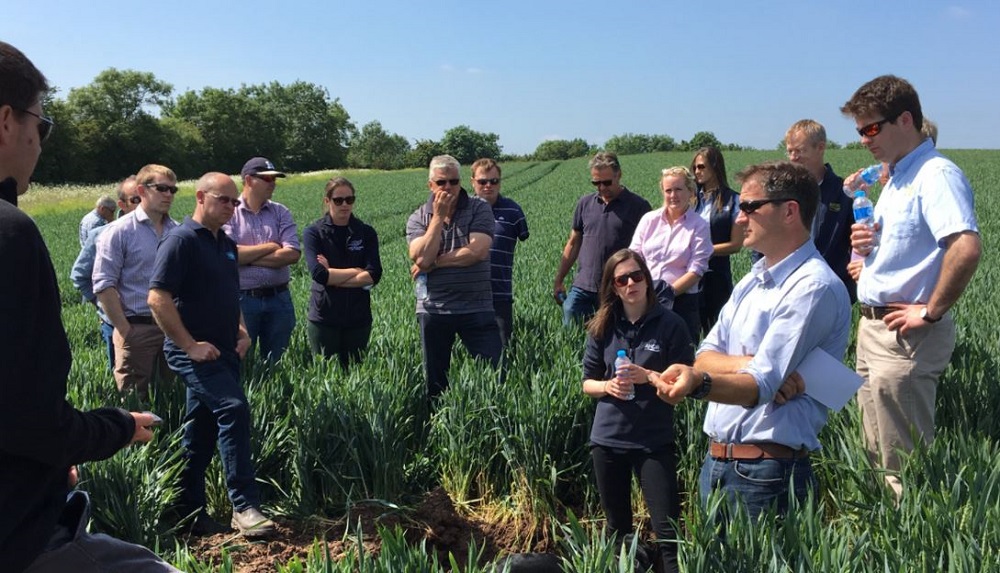- Home
- Knowledge library
- On-farm trials at Strategic Cereal Farm East (2017–2023)
On-farm trials at Strategic Cereal Farm East (2017–2023)
Summary
Host farmers: Brian and Patrick Barker (cousins)
Location: E.J. Barker & Sons, Suffolk
Duration: 2017–2023
AHDB Strategic Cereal Farms put cutting-edge research and innovation into practice on commercial farms around the UK. Each farm hosts field-scale and farm-scale demonstrations, with experiences shared via on-farm and online events to the wider farming community.
E.J. Barker & Sons is a family farm partnership and contracting business that dates to 1957. The 513 ha arable farm follows a traditional 12-year rotation, incorporating winter wheat for feed, herbage grass seed and break crops of spring barley, beans, oilseed rape or linseed.
Environmental considerations are crucial to the running of the business and are a key factor in all the decisions made on the farm.
This page features a summary of trials conducted at the farm. Details are published in downloadable reports.
Note: Except for the latest annual report (harvest 2023) and final report (2024), the reports were created from archived web pages and event handouts.
Main lessons learned
Watch Patrick Barker summarise the lessons learned at the first Strategic Cereal Farm East in this video.
Managed lower-input (fungicide) trials
This trial tested high-cost to low-cost fungicide programmes to establish a balance between reducing inputs (for economic and environmental benefits) and maintaining disease control, crop yield and profitability.
Key findings
- A lower level of fungicide active ingredient across all application timings was a more effective strategy to reduce overall fungicide input (compared to dropping a spray from the programme)
- Reducing fungicide input required a robust cultural disease control strategy in place, which focused on variety genetics, drilling dates and strong crop establishment
- Following such a strategy can help maximise net margin in high disease pressure seasons and moderate spend in low disease pressure seasons
Try this on your farm
Set up a small low-input area in your crops for a low-risk way to assess the contribution of cultural control options and improve your understanding of the seasonal disease risks on your farm.
Access AHDB fungicide performance data
Learn about the integrated management of cereal diseases
Watch Brian Barker explain how he used such ‘look-see’ trials at E.J. Barker & Sons.
Cover crops and water quality trials
This trial investigated the role cover crops play in the reduction of nitrate leaching, while considering the interaction with cultivation and rotation. It used a split-field trial design (over two fields) to compare several treatments, including an over-winter cover crop mix (rye, buckwheat, phacelia, oil radish and sunflower), an over-winter plough and an over-winter stubble (ahead of a spring crop).
Key findings
- Lower-disturbance, one-pass cultivations (strip tillage and direct drilling) reduced nitrates in drainage water by 55-66% (compared to ploughing)
- Crop cover, provided by temporary leys, oilseed rape, winter cereals and ‘out the bag’ cover crops, reduced nitrate losses by up to 50% (compared to bare or cultivated soil or stubble)
- Average nitrogen losses (across the experiment) were between 0.1 and 0.8 kg of nitrogen per day
- Based on the extremes in these trials, the equivalent cash losses ranged from £0.20 to £3.70 per day (based on ammonium nitrate at £2.00 nitrogen per kg)
- Although rough estimates, they illustrate the potential costs to the farm associated with nitrate losses
Try this on your farm
This trial showed that growing any type of crop cover helped to reduce nitrate loses. It is important to experiment with the options that best fit your system, whether that be a temporary ley or an ‘out the bag’ cover crop.
Access the AHDB cover crop web pages
Watch our November 2023 Strategic Cereal Farm results video to hear how farmers across the AHDB network are putting cover crops to work.
Flowering strip trials
This trial investigated the impact of flowering strips on the biodiversity of farmland insects and plants. A combination of trapping, nest monitoring and on-plant counts was used to measure insects.
Key findings
- The greatest insect abundance was recorded where flowering strips were placed next to an existing semi-natural habitat, such as a hedge (compared to where flowering strips were isolated within a field)
- The trial found no clear evidence of an impact of distance into the crop on pest or beneficial insect abundance. However, there is a lot of evidence from larger studies that the number of beneficial insects reduces further into the field
- Flowering strips offer a refuge for slug predators from in-field crop management. Slugs were present in all fields, with a slight trend (across years) for higher numbers in the field centres
- Recommended practice is often to cut hard and remove or bale the flowering strip in the first years after establishment. However, areas uncut in autumn 2022 delivered more flowers during drought conditions in summer 2023
Try this on your farm
Don’t spend a lot of time trying to identify and count species. There is a huge benefit in just becoming familiar with the various insects in and around your crops, as part of an integrated pest management approach.
Learn how to identify and manage pests and natural enemies
Watch Patrick Barker describe the work carried out to investigate the impact of flowering strips on farmland biodiversity at Strategic Cereal Farm East.
Marginal land trials
This trial gathered and analysed the farm’s data to identify, understand and manage variation in crop performance. It included the identification of underperforming land that may be more profitable to remove from crop production.
Key findings
- Long-term yield patterns identified field areas that were consistently underperforming in arable production. Field areas suitable for stewardship schemes were removed from arable production, with plans developed to improve the area classified as ‘marginal’ for arable production
- Yield maps, satellite imagery and soil scans helped target soil assessments to improve the understanding of marginal areas and identify ways to improve crop performance
- In general, an overall programme to cut nitrogen rates did not compromise yield or grain quality
- The exception was in high-yielding field areas, where grain nitrogen concentrations were below optimal, indicating undersupply of nitrogen to the plant
- Repeating grain and soil measurements over multiple seasons allowed the farm to refine nutrient management planning
Try this on your farm
Although analysis of yield maps is the ‘gold-standard’, a useful start is to just eyeball past yield maps to look for long-term patterns that may be a first step to identifying ‘marginal’ field areas.
Watch these videos to help you identify marginal land on your farm.
Foundation video
Advanced video
Scientific paper
This research featured in a scientific paper in Agricultural Systems (Volume 218, June 2024).
Paper highlights:
- Whole-farm spatial appraisals are rare and often without yield data validation
- The researchers processed, validated and analysed a ten-year, whole-farm yield map data set
- Wheat yield map data had an error (Root Mean Square Error, RMSE) of 1.0 t/ha, with a mean error of 8.1%
- 33% of the farm was losing over £100/ha compared to the best performing zone per field
- Yield data validation is required when developing precision agriculture techniques
Whole-farm yield map datasets: data validation for exploring spatiotemporal yield and economic stability (scientific paper)



